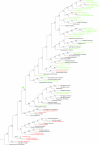Extremely variable conservation of γ-type small, acid-soluble proteins from spores of some species in the bacterial order Bacillales
- PMID: 21317325
- PMCID: PMC3133055
- DOI: 10.1128/JB.00018-11
Extremely variable conservation of γ-type small, acid-soluble proteins from spores of some species in the bacterial order Bacillales
Abstract
γ-Type small, acid-soluble spore proteins (SASP) are the most abundant proteins in spores of at least some members of the bacterial order Bacillales, yet they remain an enigma from both functional and phylogenetic perspectives. Current work has shown that the γ-type SASP or their coding genes (sspE genes) are present in most spore-forming members of Bacillales, including at least some members of the Paenibacillus genus, although they are apparently absent from Clostridiales species. We have applied a new method of searching for sspE genes, which now appear to also be absent from a clade of Bacillales species that includes Alicyclobacillus acidocaldarius and Bacillus tusciae. In addition, no γ-type SASP were found in A. acidocaldarius spores, although several of the DNA-binding α/β-type SASP were present. These findings have elucidated the phylogenetic origin of the sspE gene, and this may help in determining the precise function of γ-type SASP.
Figures





References
-
- Akaike H. 1974. A new look at the statistical model identification. IEEE Trans. Automat. Contr. 19:716–723
-
- Altschul S. F., Gish W., Miller W., Myers E. W., Lipman D. J. 1990. Basic local alignment search tool. J. Mol. Biol. 215:403–410 - PubMed
-
- Ash C., Priest F. G., Collins M. D. 1993. Molecular identification of rRNA group 3 bacilli (Ash, Farrow, Wallbanks and Collins) using a PCR probe test. Proposal for the creation of a new genus Paenibacillus. Antonie Van Leeuwenhoek 64:253–260 - PubMed
-
- Bagyan I., Noback M., Bron S., Paidhungat M., Setlow P. 1998. Characterization of yhcN, a new forespore-specific gene of Bacillus subtilis. Gene 212:179–188 - PubMed
Publication types
MeSH terms
Substances
LinkOut - more resources
Full Text Sources
Molecular Biology Databases
Miscellaneous

